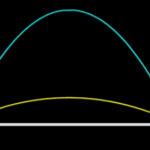What is D-Alembert’s Principle in Engineering Mechanics?

Consider a rigid body acted upon by a system of forces. The system may be reduced to a single resultant force (P) acting on the body whose magnitude is given by the product of the mass of the body (m) and the linear acceleration (a) of the center of mass of the body. According to Newton’s second law of motion,
P = m.a
or P – m.a = 0
or P + FI= 0 (Where FI is Inertia Force)
Thus D-Alembert’s principle states that the resultant force acting on the body together with the reversed effective force or inertia force are in equilibrium.


